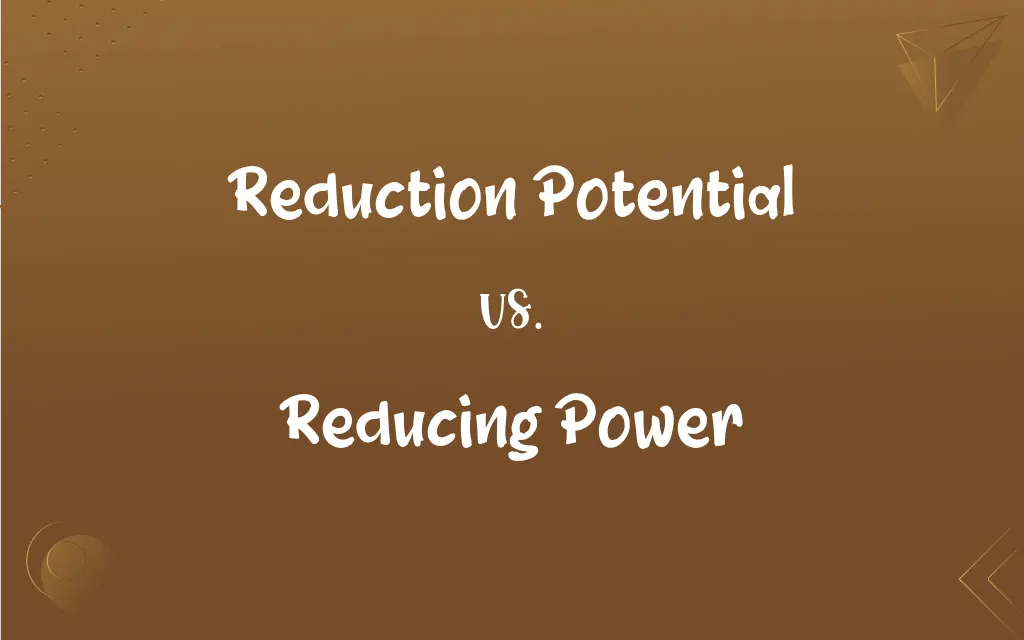Reduction Potential vs. Reducing Power: What's the Difference?
Edited by Aimie Carlson || By Janet White || Published on December 3, 2023
Reduction potential is a measure of a substance's tendency to gain electrons, while reducing power refers to its ability to reduce other substances.

Key Differences
Reduction potential, represented as a voltage in electrochemical cells, indicates how likely a substance is to gain electrons in a redox reaction. Reducing power, on the other hand, describes the capacity of a substance to donate electrons to another substance, facilitating its reduction.
Reduction potential is quantitatively measured using standard electrode potentials, providing a scale to compare different substances. Reducing power is more of a qualitative concept, describing the general electron-donating ability of a substance.
Reduction potential is a concept rooted in electrochemistry, important in understanding and predicting the direction of redox reactions. Reducing power is related to the chemical reactivity of a substance, indicating how effectively it can bring about the reduction of other substances.
Reduction potential is usually measured under standard conditions, making it a standardized and comparable value. The reducing power of a substance can vary with conditions such as concentration, temperature, and the presence of other reactants.
Reduction potential is often used as a reference in electrochemistry for understanding redox reactions, battery design, and corrosion. Reducing power is crucial in various chemical processes, including organic syntheses, metallurgy, and biochemistry.
ADVERTISEMENT
Comparison Chart
Nature
Quantitative measure of tendency to gain electrons
Qualitative capacity to donate electrons
Measurement
Expressed in voltage, using standard electrode potentials
Assessed based on reactivity and context-specific factors
Context
Electrochemical
Chemical reactivity
Standardization
Measured under standard conditions
Depends on various conditions
Application
Predicting redox reactions, battery technology
Chemical synthesis, metallurgy, biochemistry
ADVERTISEMENT
Reduction Potential and Reducing Power Definitions
Reduction Potential
A key factor in determining the direction of redox reactions.
In a galvanic cell, the substance with higher reduction potential is reduced.
Reducing Power
Plays a role in biochemical reactions within living organisms.
NADH is known for its reducing power in cellular respiration.
Reduction Potential
Standard reduction potentials are referenced against the hydrogen electrode.
The standard reduction potential table helps predict the outcome of electrochemical reactions.
Reducing Power
Important in metallurgical processes for extracting metals.
Carbon's reducing power is exploited in the smelting of iron ore.
Reduction Potential
A measure of the tendency of a chemical species to acquire electrons and be reduced.
The reduction potential of copper is higher than that of zinc.
Reducing Power
Indicates how effectively a substance can bring about the reduction of others.
In organic chemistry, agents with high reducing power are essential for certain reactions.
Reduction Potential
Expressed in volts, it quantifies how strongly a species undergoes reduction.
Electrochemical cells are designed based on the reduction potential of their components.
Reducing Power
The ability of a substance to donate electrons in a chemical reaction.
Hydrogen gas has a strong reducing power, making it useful in reducing metal oxides.
Reduction Potential
Influential in battery design and corrosion processes.
Metals with lower reduction potentials are more prone to corrosion.
Reducing Power
Varies with the substance's chemical nature and reaction conditions.
The reducing power of a substance can increase with higher temperature.
FAQs
What is reduction potential?
It's a measure of the tendency of a chemical species to gain electrons.
What does reducing power mean?
It refers to a substance's ability to donate electrons and reduce other substances.
How is reduction potential measured?
It's measured in volts, using standard electrode potentials.
Is a higher reduction potential indicative of a stronger oxidizing agent?
Yes, a higher reduction potential indicates a stronger tendency to gain electrons, making it a stronger oxidizing agent.
What factors influence reducing power?
Concentration, temperature, and the chemical nature of the substance.
Is reducing power important in industrial processes?
Yes, especially in metallurgy and chemical manufacturing.
How does temperature affect reducing power?
Generally, increasing temperature can enhance the reducing power of a substance.
Does the pH affect reduction potential?
Yes, pH can influence the reduction potential of substances, especially in aqueous solutions.
Can reduction potential predict the direction of a redox reaction?
Yes, it helps predict which species will be oxidized or reduced.
Are reduction potentials always constant?
They are measured under standard conditions but can vary under different conditions.
What affects the reducing power in metallurgical processes?
The nature of the reducing agent and the reaction conditions, like temperature and pressure.
Can reducing power be quantified?
It's more qualitative but can be inferred from chemical reactivity and context.
Can reduction potential be used in environmental analysis?
Yes, it's used in assessing redox conditions in environmental samples.
How does reduction potential relate to corrosion?
Metals with lower reduction potentials are more prone to corrosion in certain environments.
Does reducing power relate to oxidation?
It relates inversely; a substance with high reducing power is a poor oxidizing agent.
What role does reducing power play in biochemistry?
It's crucial in processes like cellular respiration and photosynthesis.
How do you determine the reduction potential of a substance?
It's determined using electrochemical cells and referencing standard electrode potentials.
What is an example of a substance with high reducing power?
Sodium borohydride is an example with high reducing power in chemical reactions.
Why is reducing power important in organic synthesis?
It's essential for reactions that involve the reduction of organic compounds.
What is a standard reduction potential?
It's the reduction potential of a substance measured against a standard hydrogen electrode.
About Author
Written by
Janet WhiteJanet White has been an esteemed writer and blogger for Difference Wiki. Holding a Master's degree in Science and Medical Journalism from the prestigious Boston University, she has consistently demonstrated her expertise and passion for her field. When she's not immersed in her work, Janet relishes her time exercising, delving into a good book, and cherishing moments with friends and family.
Edited by
Aimie CarlsonAimie Carlson, holding a master's degree in English literature, is a fervent English language enthusiast. She lends her writing talents to Difference Wiki, a prominent website that specializes in comparisons, offering readers insightful analyses that both captivate and inform.







































































